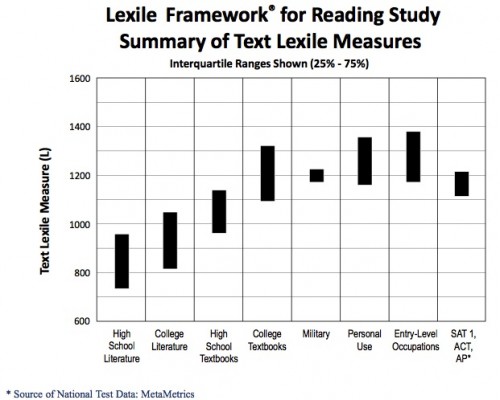Reading is an active and complex task that requires the brain to use a multitude of cognitive skills and mental processes to develop meaning and comprehension from written text. Being able to read high-level text independently and fluently is essential for high achievement, not only in academia but also in the workplace and through numerous life tasks. However there is a serious gap between many high school seniors’ reading ability and the reading requirements they face after graduation.
Consider the chart below. The Lexile Measure for reading level of high school literature and textbooks falls short of the level typical of college, military and workplace material. And when you take into consideration the reading level of most standardized assessments for high school students, a Lexile range of 1000-1100, the gap becomes even more evident. Simply put, students are leaving high school with limited exposure to higher-level text and contact with reading standards and assessments that don’t adequately align to meet the real world conditions they’ll be confronted with.

Research conducted by ACT’s College Readiness Benchmark for Reading indicates that just over half of our nation’s students who are on a college preparatory track are able to meet the demands and rigor of postsecondary and workplace requirements. And if that isn’t daunting enough, data from the most recent reading assessment conducted by the National Assessment of Educational Progress (NAEP) reveals that only 38% of high school seniors tested at or above proficiency for 12 thgrade standards. This bodes ill for the ability of Americans to meet the demands and challenges of a highly competitive global marketplace and begs the question, “Why aren’t our schools’ reading standards higher?”
Studies show that aligning high school standards to college and workplace expectations is a critical step toward giving students a solid foundation in the academic, social and workplace skills needed for success in a postsecondary education or career. The American Diploma Project has found that there is a common core of knowledge and skills, particularly in English and math, that students must master to be prepared for both postsecondary education and well-paying jobs. The research shows that there is a strong correlation between scores in high school math and English and wages earned once in the workplace. Students who are taking below-average or functional/basic classes increase their likelihood of being employed in a low-paid or low-skill job, compared to students in the top quartile who earn significantly more in the decade following high school than their ‘average’ or low performing peers.
As we seek to curtail the disparity between what’s taught in K-12 classrooms and what’s expected in the real world, it’s important that we coordinate with our local and national education and business leaders, help them to provide a cohesive approach to improve the rigors of academic coursework, promote relevant and innovative learning opportunities for all students, and share information and resources that advance the coordination across the K-12 and postsecondary sectors of our society. And by all means if you can read this, thank a teacher!
References:
Malbert Smith III, Ph.D. Bridging the Readiness Gap: Demystifying Required Reading Levels for Postsecondary Pursuits.Lexile.com.
Related Reading:

